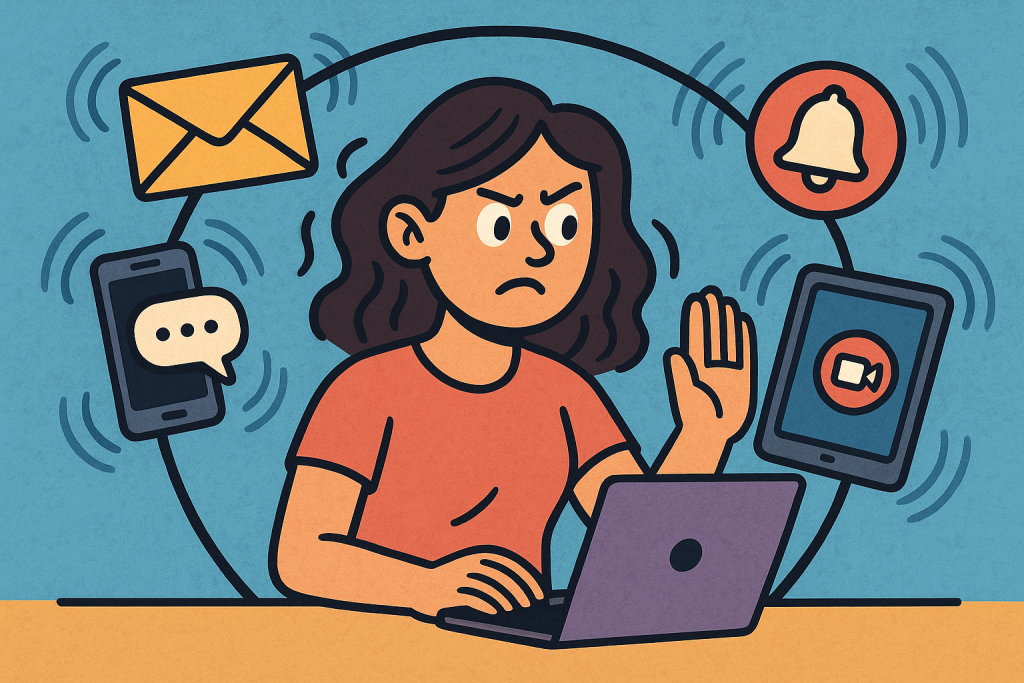Digital noise—endless pings, social feeds, AI alerts—can distract, drain energy, and blur the line between work and life. In 2025, being intentional about digital boundaries is not just helpful—it’s essential. This “set boundaries with digital noise” guide explores today’s top trends and gives you clear strategies to protect focus and digital wellbeing.

1. Why Learning How to Set Boundaries With Digital Noise Matters
Smartphones, wearables, AI assistants—our tools are also triggers. A recent study showed that 63% of knowledge workers feel interrupted every 10 minutes by digital notifications, significantly harming concentration and cognitive bandwidth¹. Learning how to set boundaries with digital noise means reclaiming time, improving productivity, and reducing stress.
2. Trend Spotlight: Smart Notification Management
Advances in AI are making notifications smarter. Platforms like Android 15 and iOS 18 now offer priority-based silencing, filtering alerts by sender and topic relevance. Apps like SparkMail and Slack integrate AI that triages and prioritizes incoming messages based on urgency. Still, you must set your rules:
- Review apps and notifications weekly: Determine which alerts genuinely matter.
- Use focus modes: Allow only essential contacts or apps during work blocks.
- Batch notification checks: Set designated times (e.g. twice daily) to reduce interruptions.
3. Strategy: Create Intentional Digital “Zones”
Borrowing from architectural zoning, apply this to your digital world:
- Focus zones: Use “Do Not Disturb,” focus modes, or airplane mode during deep work.
- Social zones: Set specific times for feeds or chats.
- Recharge zones: No screens at least 1 hour before bedtime to protect sleep.
Structure like this helps reduce cognitive load and prevent random digital drift.
4. Tech Tools That Respect Your Boundaries
Here are tools that empower you to enforce digital calm:
| Tool | What It Does | Why It Helps |
|---|---|---|
| Freedom.app | Blocks apps/sites across devices | Use for deep work blocks |
| Forest | Encourages focus by growing virtual trees | Visual accountability |
| RescueTime | Tracks time on apps & sites | Helps you understand where noise comes from |
Pairing these with clear boundaries—like “no news apps after 7 pm”—gives structure and consistency.
5. Mindful Practices to Reinforce Healthy Digital Habits
Behavioral changes support technical solutions:
- Set an intention before picking up your phone. Ask: “Is this productive, restful, or necessary?”
- Reflect weekly: What interruptions pulled you off-track? Adjust zones and app restrictions accordingly.
- Communicate digital boundaries clearly: Let colleagues know your focus hours. Update status messages or email auto-responses.
This awareness—known as “digital self-regulation”—enhances control and long-term digital health².
6. Deep Work: The Gold Standard for Focus
Cal Newport’s Deep Work is increasingly cited as essential in the age of AI-generated distractions. His principle: protect long uninterrupted time each day (90-minute blocks) for cognitively demanding tasks³. Apply your digital boundaries to honor these sessions—silence notifications, close tabs, and commit to one task.
7. Challenge: Digital Minimalism—What Sometimes Means Less
2025 sees a shift toward “smart decluttering.” Inspired by Cal Newport’s Digital Minimalism, this movement suggests reducing app clutter, deleting seldom-used accounts, and keeping only what adds real value. Periodic digital detoxes—like a one-week “Information Fasting Retreat”—can reset attention and reboot focus.
8. Sample Routine: Boundaries in Action
Here’s how to operationalize your boundaries:
- 7:00–8:00AM: Morning routine (no screens)
- 8:00–11:00AM: Deep work block—focus mode on, only essential notifications
- 11:00–11:15AM: Check important messages
- 11:15–1:00PM: Task work; only project-specific apps
- 1:00–2:00PM: Lunch and screen break
- 2:00–4:00PM: Client calls; notifications on for communication tools only
- 4:00–5:00PM: Review and respond to non-urgent messages
- 5:00–7:00PM: Personal time—social apps allowed; news blocked
- 7:00–8:00PM: Dinner (no screens)
- 8:00–9:00PM: Leisure content; screen-free bedtime wind-down
This schedule changes by week, but boundaries remain consistent.
9. Measuring Success & Avoiding Burnout
Monitor metrics like focus time (RescueTime) and sleep quality (wearables). Lower anxiety and deeper focus emerge within weeks—per research on digital boundary interventions⁴. Adjust based on signals like “too many wake-up pings” or “mindless app hopping.”
10. When You Slip—Stay Flexible
It’s normal. Missed zones or reactive scrolling? Just reset:
- Pause and evaluate: Which digital noise pulled you off track?
- Adjust immediately: Seal the weak spot—turn off alerts, tweak filters.
- Reinforce gently: Remind yourself of the benefits and restart the habit.
Boundaries aren’t perfect—they’re fuel for purpose and productivity.
Final Takeaways
- Learn how to set boundaries with digital noise using smart notifications, structured zones, and behavioral tactics.
- Embrace deep work and digital minimalism to create space for focused, meaningful work.
- Track progress, iterate, and forgive yourself—digital boundaries are an ongoing practice, not a one-off fix.
Establishing these boundaries empowers you to work better and live calmer in 2025’s noisy digital world.
References
Foster, E. (2025). Digital Detox: Finding the Balance in a Hyper-Connected World. N.C. State University Center for Environmental Studies. Retrieved from https://bertie.ces.ncsu.edu/2025/01/digital-detox/
Weber State University Academic Peer Coaching. (n.d.). Creating Digital Boundaries: Having a Strategy for Managing Technology. Retrieved from https://www.weber.edu/academicpeercoaching/blog/digital-boundaries.html
Wired Staff. (2025). 7 Ways to Limit Your Endless Doomscrolling. Wired. Retrieved from https://www.wired.com/story/7-ways-to-limit-your-endless-doomscrolling






